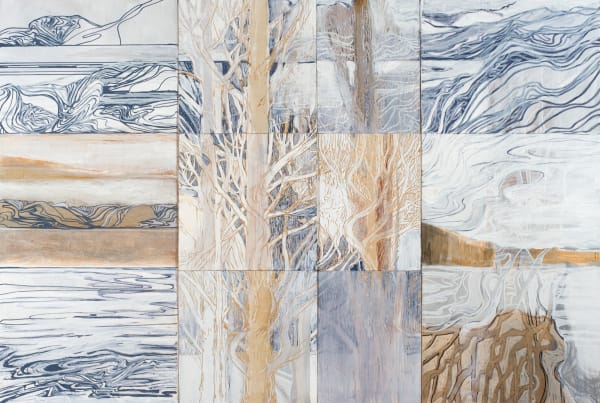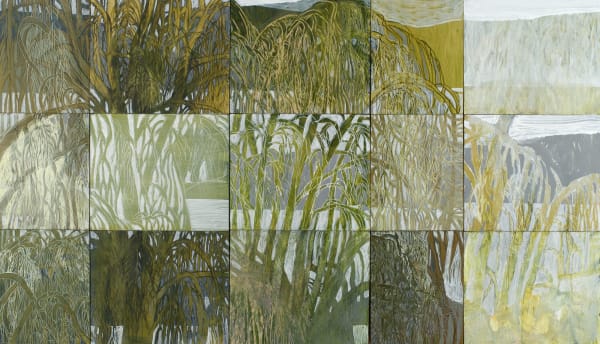Caroline Rannersberger: Tree Change
The notion of tree change covers several aspects of my practice. Broadly, it is about the new ground I have traversed this year, both in terms of location and in my art making.
I have shifted place. I have extended my practice from working on Lunawanna-Alonnah/Bruny Island with mountain views across the ocean; to also take in Hobart, where I am surrounded by tall eucalypts that cascade down from Kunanyi/Mt Wellington towards nipaluna/Hobart city waterfront.
I have shifted my subject matter. I have broadened my focus to drawing and painting trees. I still paint the wide ocean landscape with hills and mountains, now filtered and framed by trees. On Bruny Island I draw and paint the 25 year old Huon Pines that grow in our garden. In Hobart the tall eucalypts dominate.
I have incorporated new material, wood panels. There are a number of reasons for this. The material dimension of my practice and the process of working with wood is fundamental in making artworks with trees as the subject. Essentially, the material doesn’t change, rather the matter changes at an elemental level. In my case it is quite simple; the wood panels are a different form of trees, and I use them to represent trees visually and through the material itself.
My focus has shifted slightly. I am beginning with detail and moving literally, to the bigger picture. I begin by drawing on the small wood panels and then compose them, in some cases framed by linen panels, into a larger piece by moving them around and forming new connections. The original drawings are always created from life. The sensation of the ‘life drawing’ approach is vital to how I see landscape as a process of constant shift and change and force and movement. The final work is a multitude of small fragments and views, brought together as a kind of conversation between all the different elements.
Art historically, I have looked back at the period of the Secession in Vienna and the Art Nouveau style I came to appreciate whilst living in Vienna as a student. Gustav Klimt, one the main protagonists, is a well-known exemplar, and some of his work takes in the Bavarian landscape close to where I spent time as a teenager and young adult; an early influence on my practice. I have since revisited some of Klimt’s works and other key Secession artists; whilst drawing the pendulous branches of the Huon Pine and the intersecting limbs of the soaring eucalypts; and observing the flowing forms of hillsides and mountains and ocean. I observe the flow and folds as a kind of stylised movement, recalling forms and shapes in the manner of art nouveau that celebrated nature and beauty.
I am still using many of the methods and materials I have always worked with. Multiple panels: acrylics, drawing, painting, and even carving. I constantly shift the panels around, creating new intersections across different perspectives, slightly disjunctive. I see the milieu of my surrounds as a complex and infinite intersection across space and even time. As always, I draw en plein air, both in Hobart and on Bruny. I often take the panels with me, reworking them wherever I happen to be. These are all ways in which I compose and present my work.
Caroline Rannersberger
Painter, installation artist, printmaker and curator Caroline Rannersberger responds intuitively to her environment, referencing in particular the rhizomatic model of Deleuzian philosophy (Gilles Deleuze). This philosophy opens up a new way of ‘seeing’ the landscape through acknowledging that rather than one fixed viewpoint, landscape contains multiple and shifting points of connection across time and space. Rannersberger has explored these themes closely over the last ten years, in particular, through her research towards her Master of Visual Arts, with a focus on the sublime, and subsequently her PhD, with a broader emphasis on experience and sensation in the landscape.
Rannersberger’s work reflects the extreme forces of the remote regions she has experienced, across northern Australia and to the far south, as well as the alpine regions of Austria and Germany, where she was raised and educated. Foreboding mountains, rising from within vast oceans, all but crushed beneath the forces of impending storm clouds towering over the land. As such, working predominantly across paper and linen, Rannersberger’s multiple panel landscapes reference the sensations of her Tasmanian surrounds, elements of her north Australian experiences and her German heritage. Her work is in the collections of the National Gallery of Australia, The Museum and Art Gallery of the Northern Territory (MAGNT), and Artbank. She has been a finalist in numerous prizes, including the Glover prize, the Fleurieu Art Prize, the ABN Amro Emerging Artist Award, the Fremantle Print Award, & the Alice Prize.
'In all her works we observe the observer, we experience an encounter that seems impossible, that of seeing the sensation of seeing and its apparent dissolution. She attempts to capture that tremulous state, what Alain Badiou has called elsewhere, "the movement of disappearance", a disturbance not yet transformed into an object nor cast in negation as an absence, but rather the actuality of disappearance itself.' Professor Donal Fitzpatrick, 2012
-
 Caroline RannersbergerOchre Trees and Ocean , 2022acrylic on wood panel and Belgian linen8 panels: 92 x 135.5 cm (overall size)AU$ 9,000.00
Caroline RannersbergerOchre Trees and Ocean , 2022acrylic on wood panel and Belgian linen8 panels: 92 x 135.5 cm (overall size)AU$ 9,000.00 -
 Caroline RannersbergerSienna Trees and Ocean , 2022acrylic on wood panel and Belgian linen8 panels: 92 x 135.5 cm (overall size)AU$ 9,000.00
Caroline RannersbergerSienna Trees and Ocean , 2022acrylic on wood panel and Belgian linen8 panels: 92 x 135.5 cm (overall size)AU$ 9,000.00 -
 Caroline RannersbergerWhite Trees and Ocean, 2022acrylic on wood panel and Belgian linen8 panels: 92 x 135.5 cm (overall size)AU$ 9,000.00
Caroline RannersbergerWhite Trees and Ocean, 2022acrylic on wood panel and Belgian linen8 panels: 92 x 135.5 cm (overall size)AU$ 9,000.00 -
 Caroline RannersbergerHuon Pine 1, 2022acrylic on wood panel12 panels: 90 x 60 cm (overall size)AU$ 6,000.00
Caroline RannersbergerHuon Pine 1, 2022acrylic on wood panel12 panels: 90 x 60 cm (overall size)AU$ 6,000.00 -
 Caroline RannersbergerHuon Pine 2 , 2022acrylic on wood panel15 panels: 133 x 75 cm (overall size)AU$ 8,000.00
Caroline RannersbergerHuon Pine 2 , 2022acrylic on wood panel15 panels: 133 x 75 cm (overall size)AU$ 8,000.00 -
 Caroline RannersbergerHuon Pine 3, 2022acrylic on wood panel12 panels: 90 x 110 cm (overall size)AU$ 8,000.00
Caroline RannersbergerHuon Pine 3, 2022acrylic on wood panel12 panels: 90 x 110 cm (overall size)AU$ 8,000.00 -
 Caroline RannersbergerHuon Pine 4, 2022acrylic on wood panel12 panels: 90 x 110 cm (overall size)AU$ 8,000.00
Caroline RannersbergerHuon Pine 4, 2022acrylic on wood panel12 panels: 90 x 110 cm (overall size)AU$ 8,000.00 -
 Caroline RannersbergerHuon pine wide 1, 2022acrylic on wood panel and Belgian linentriptych: 40.5 x 153 cm (overall size)AU$ 7,600.00
Caroline RannersbergerHuon pine wide 1, 2022acrylic on wood panel and Belgian linentriptych: 40.5 x 153 cm (overall size)AU$ 7,600.00 -
 Caroline RannersbergerHuon Pine Wide, 2, 2022acrylic on wood panel and Belgian linentriptych: 40.5 x 153 cm (overall size)AU$ 7,600.00
Caroline RannersbergerHuon Pine Wide, 2, 2022acrylic on wood panel and Belgian linentriptych: 40.5 x 153 cm (overall size)AU$ 7,600.00 -
 Caroline RannersbergerHuon Pine wide 3 , 2022acrylic on wood panel and Belgian linentriptych: 40.5 x 153 cm (overall size)AU$ 7,600.00
Caroline RannersbergerHuon Pine wide 3 , 2022acrylic on wood panel and Belgian linentriptych: 40.5 x 153 cm (overall size)AU$ 7,600.00 -
 Caroline RannersbergerHuon Pine Wide 4, 2022acrylic on wood panel and Belgian linentriptych: 40.5 x 153 cm (overall size)AU$ 7,600.00
Caroline RannersbergerHuon Pine Wide 4, 2022acrylic on wood panel and Belgian linentriptych: 40.5 x 153 cm (overall size)AU$ 7,600.00












